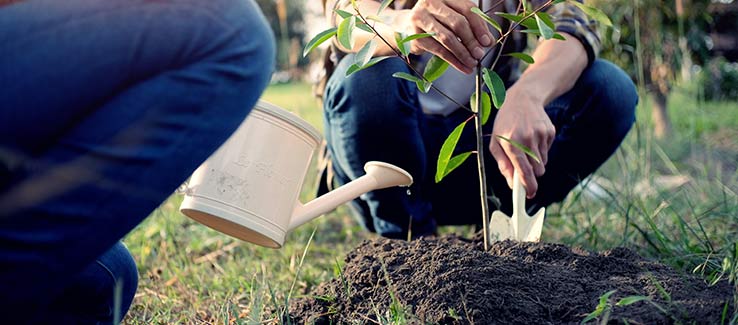Tree Care Tips
Prevent your trees from becoming a hazard to your property and wellbeing. By knowing how to care for your trees, you can add decades to their lifespan while protecting yourself and property.
fasttreeremovalatlanta.com gathered the following tree care tips that promote the health of your tree from the time you plant it through its maturity.
Plant the Right Tree in the Right Place
Tree care begins when you select a species that fits your yard or landscape. Then, planting that tree in the right location will save you from dealing with grave tree health problems down the road. Consider the following:
Species – When selecting a tree species for your yard or landscape, you should answer the following questions:
- Is the species evergreen or deciduous? Deciduous trees lose their foliage in the fall.
- Is the species understory or overstory? Overstory species can reach 80 to 100 feet or more.
- Is the species flowering or fruit-bearing? After several years of growth, you may have an annual harvest to feast on.
- Is the species known to have invasive roots? Invasive roots can cause expensive damage to foundations and underground utilities.
Location – Determine multiple potential locations to plant your tree. Just because you think it would look good in one space doesn’t mean it has sufficient room or optimal conditions to reach maturity.
Look Up – Depending on the species of the tree you want to plant, consider its maximum height at maturity and if it will interfere with anything overhead i.e., power lines, road to house connections, etc.
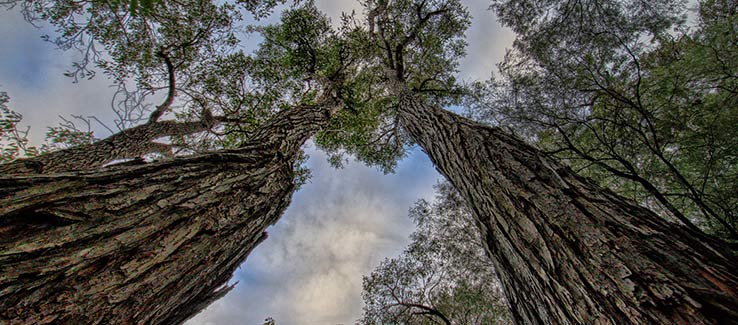
What’s Below – As your tree grows upward, root growth will occur downward and outward. Verify the location of water mains, sewage lines, septic tanks, underground utilities, etc.
Call 8-1-1 to request a property inspection or visit call811.com to see the requirements and/or regulations in your state.
What Surrounds the Location – Your planting site should be 15 to 20 feet from driveways, sidewalks, fences, your home, and other structures to avoid root damage as the tree matures.
Read more about planting trees at fasttreeremovalatlanta.com/tree-planting-location-landscape-species
How To Select a Healthy Tree
Once you’ve chosen the species and future location of your tree, observe the following to select a healthy specimen to plant:
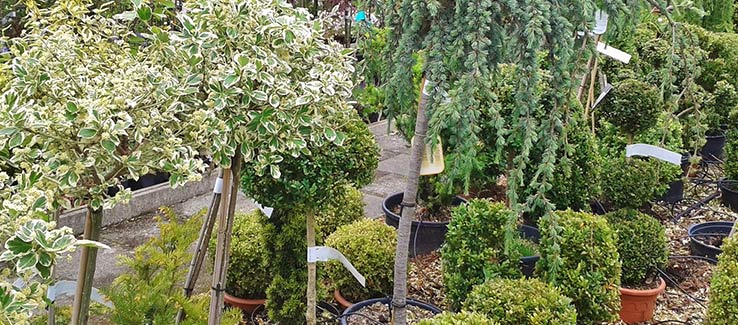
Examine The Tree – It should look healthy with bright bark, and include the following:
- A well-developed leader
- Well-distributed branches
- Branches low on the trunk
- Free from signs of disease and insect infestation
- Free from signs of mechanical injury and breaks
Avoid purchasing trees with signs of drought. Take extra care to examine the foliage, twigs, and limbs. They should be firm but flexible, without signs of drying.
Examine The Roots – Before settling on a specimen, look for the following traits in its roots:
Bare-Root Seedlings and Saplings – When looking at bare-root specimens, the roots should be:
- Free from damage or breaks
- Moist and developed
- Roughly the length of its stems (for deciduous species)
If something looks or feels wrong, chances are, it is wrong. Be very selective when choosing a tree to plant.
Watch this video to see how bare-root trees are properly planted.
Balled and Burlapped Trees – These are trees that have had their root ball preserved and are typically wrapped in burlap. The following should be observed when looking at balled or burlapped trees:
- The root ball should be firm
- It should be moist but not wet
- The root ball should be proportional to the tree’s size
- The root ball should be firm around the trunk (no slack)
Avoid purchasing trees that appear loosely attached to their root ball. Chances are the root system has sustained significant damage or has dried out.
Watch this video to see how balled and burlapped trees are properly planted.
Container-Grown Trees – Container-grown trees can come with severe root growth problems. Inspect tree roots growing in containers as follows:
- If the container contains large, circling roots, these roots will likely continue to circle when planted in the ground. This condition may lead to the girdling and premature death of your tree.
- If roots have been pruned, examine them closely. Pruned roots should have clean cuts, while larger roots should be left intact.
- Like with burlapped root balls, the soil and roots should be firmly joined together.
As with bare-root and burlapped trees, container-grown trees should appear healthy with no signs of disease or insect infestation. Read more about warning signs and tree problems at fasttreeremovalatlanta.com/warning-signs-problems-solutions-atlanta-trees
Watch this video to see how container-grown trees are properly planted.
Watering Your Trees
From the time your trees are planted, through maturity, they will need moist, well-drained soil for healthy growth.
Newly planted trees need regular and consistent watering until their root systems establish. Root systems of trees, whether bare-root, balled and burlapped, or container, are severely restricted and require more frequent waterings. Consider the following watering intervals:
- Daily watering for two weeks after planting
- Every three days from three weeks to twelve weeks
- Weekly deep waterings after twelve weeks
Once planted, root systems grow and establish themselves until they expand much wider than the canopy of the tree. This process takes one and a half to two years, and watering intervals should continue through this time.
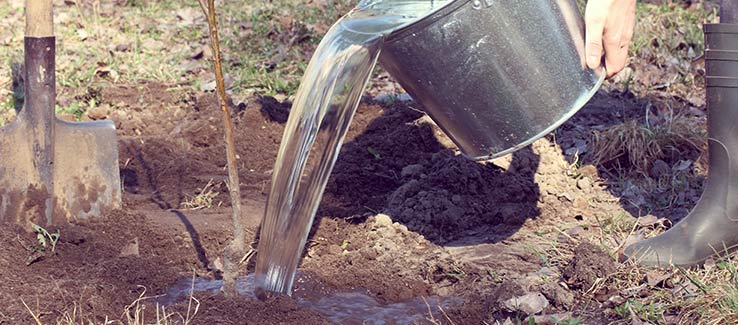
The amount of water your tree requires can be calculated by the caliper of its trunk at planting. For trees with diameters up to four inches, measure the trunk six inches above the ground. For those greater than four inches, measure the trunk at twelve inches above the ground.
For every inch in diameter, your tree will require 1 to 1.5 times that number in gallons of water per irrigation. Coincidentally, The time it takes for the tree’s roots to establish themselves is also 1.5 times that number in years. For example:
- 1-inch caliper requires 1.5 years and 1 to 1.5 gallons per irrigation
- 3-inch caliper requires 4.5 years and 4 to 4.5 gallons per irrigation
- 5-inch caliper requires 7.5 years and 5 to 7.5 gallons per irrigation
Note: A deep watering soaks the ground around the tree to a depth of nine to twelve inches. This type of watering encourages roots to grow deep and away from the tree, establishing a sturdy root plate.
Tip: Avoid overhead watering to prevent the unintentional spreading of harmful pathogens to your trees.
Mulching Your Trees
Mulching newly planted trees with three inches of organic mulch optimizes root production by:
- Helping the soil retain moisture
- Acts as an absorbent, preventing water runoff
- Insulates the soil from extreme heat and/or cold temperatures
- Helps prevent soil compaction
- Improves soil as it decomposes
- Decreases competition from turf and weed roots
Tip: Keep mulch from contacting the trunk or root flare of the tree. This helps prevent rot.
Note: Using too much mulch can suffocate roots or cause the soil to retain too much water, leading to root rot.
Watch this video to see mulching best practices.
Fertilizing Your Trees
Fertilizer is often misused, it is not plant food. Trees produce their own food by making sugars through a process called photosynthesis. The minerals and/or nutrients released by fertilizer provide needed ingredients for photosynthesis and growth to occur.
Fertilizer applied in the first years of established, transplanted trees can speed up canopy growth and help young trees fill up space in your landscape. Slow-release fertilizers are recommended for recently planted trees and shrubs.
Nutrients commonly found in fertilizers are nitrogen (N), phosphorus (P), and potassium (K). Other nutrients used in fairly large quantities are calcium, magnesium, and sulfur. Organic fertilizers, like compost, cow manure, or fertilizer blends, provide nitrogen and other nutrients slowly. An advantage of organic fertilizers is their delivery of minor nutrients (minerals required in small amounts such as iron or zinc) not usually found in commercial fertilizers. Organic fertilizers also improve soil structure.
Soil pH should be tested annually and adjusted as needed. Generally, the best growing conditions for trees occur in soils with a pH of 6.5 to 7.0. However, some species may require more acidic or more basic soils.
Tip: If you annually fertilize your turf with a slow-release fertilizer, you will likely not need to fertilize your trees.
Read more about fertilizing trees at fasttreeremovalatlanta.com/fertilization-basics-healthier-trees
Pruning Your Trees
Typically, people will prune to improve the aesthetics of a tree by removing unwanted growth. However, trees are often pruned only to maintain a desired shape or size to fit a location. This is usually the result of a poor choice of location or because the wrong tree species was selected for that space.
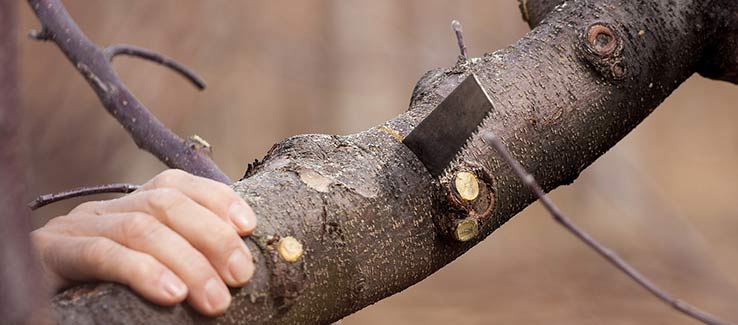
The best time to prune a tree is when it is in its dormancy period, generally at the very begging of winter or just before spring. During this time, the risk of infection is minimal, and potential damage to the tree is significantly reduced. Consider the following when pruning a tree:
- Always prune with purpose
- Before pruning, make sure your tools are sterile
- Before starting, learn how and where to cut
- A wound is forever contained by compartmentalization within the tree, a lot of care should be applied when deciding what to prune
- Tree growth problems are best corrected when they are young. Smaller cuts do lesser damage than larger cuts.
When trees are damaged by a storm or suffer damages from illnesses and infestations, prune to remove affected limbs.
Watch this video to see pruning best practices.
Note: When in doubt about pruning, hire a professional tree service to evaluate your tree and do the pruning for you.
Read more about pruning and caring for young trees at fasttreeremovalatlanta.com/3-tips-young-trees-pruning-tree-care-protection
Caring for Trees
In this article, you discovered tips to help your trees thrive from the time they are planted through their maturity.
By knowing how to provide proper care for your trees, you are giving them the chance to live a long, sturdy life.
When you plant a tree and simply let it be, you create the risk for abnormal growth, diseases, and insect infestations that can weaken and quickly kill your tree.
Sources:
extension.umn.edu/planting-and-growing-guides/watering-newly-planted-trees-and-shrubs
extension.psu.edu/mulching-landscape-trees
hgic.clemson.edu/factsheet/fertilizing-trees-shrubs/
arborday.org/trees/tips/
extension.msstate.edu/publications/soil-ph-and-tree-species-suitability-mississippi
(404) 220-9965
(404) 220-9963

